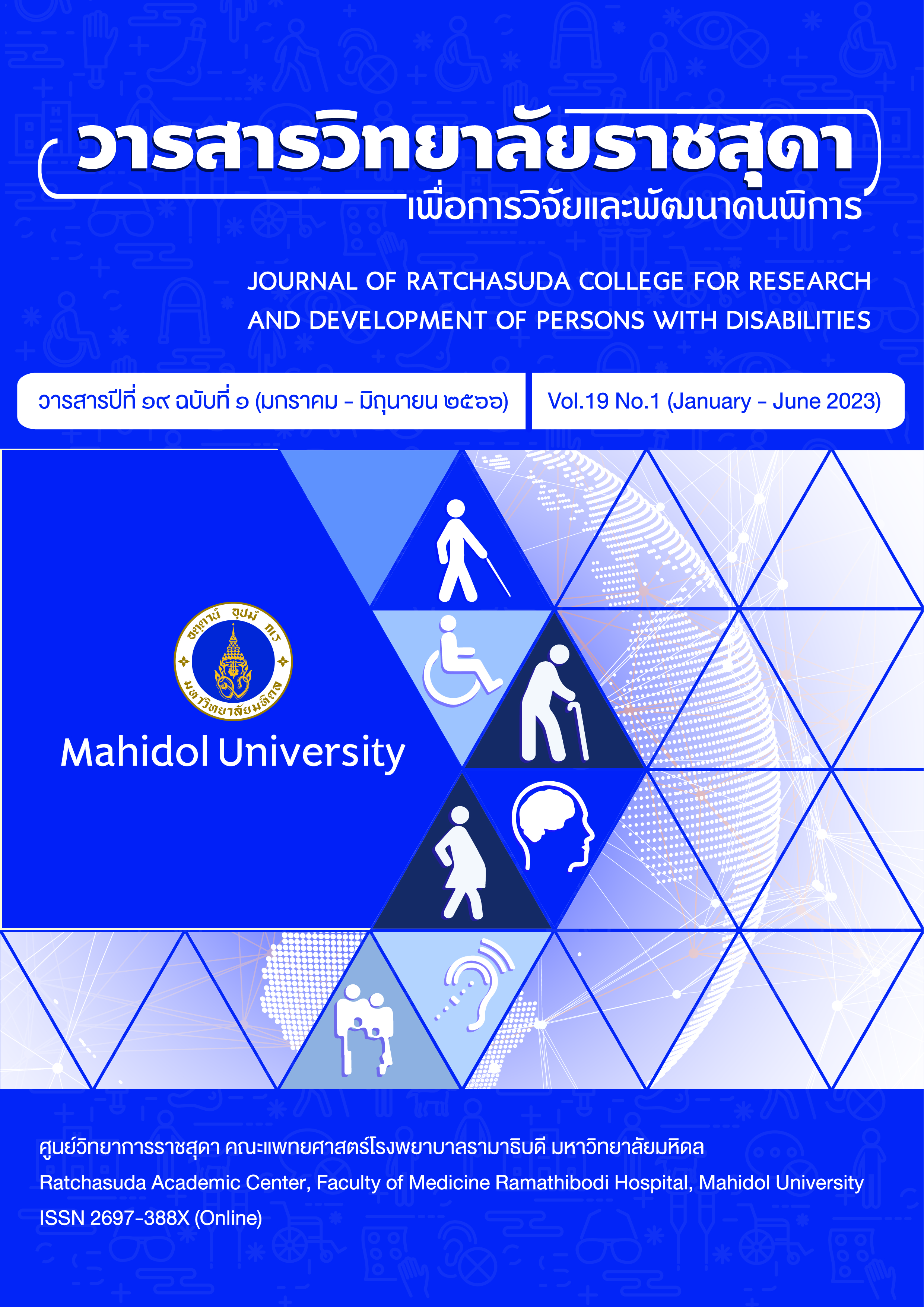The Study on Using Assistive Technologies for Hearing-Impaired Undergraduate Students
Keywords:
Assistive Technology, Hearing-Impaired Undergraduate Students, Media, Educational ServicesAbstract
The study on using assistive technologies for hearing-impaired undergraduate students aimed to study the conditions of using assistive technology, and to study the relationship between personal characteristics of undergraduate students with hearing impairment and using assistive technology. The study was implemented to 118 students with hearing impairment obtained by purposive sampling, from 17 universities based on the calculated proportion of students with hearing impairment in public higher education institutions of Thailand. The instrument was a Google Form questionnaire about using assistive technology, with Thai sign language video clip for the descriptions. The questionnaire consisted of 2 parts, 1) personal and general data of students with hearing impairment, and 2) data about using assistive technology for students with hearing impairment. The university coordinators were requested to forward the questionnaire to students with hearing impairment for QR Code scanning. The questionnaire was collected in 2021. The statistics used were descriptive statistics and inferential statistics for data description. The hypothesis testing were conducted using ANOVA. The mean difference between groups were compared by multiple comparison. It was found that the highly required items of assistive technology included smartphones, laptops, sign language interpreters, tablets, VDOs for lesson review, and captioning. The moderately required items included desktop computers, notetaker, hearing aids, and scrolling texts. As for personal characteristics that caused the differences of the requirement levels of using assistive technology, they were found as follows. Their years of study caused the difference of using tablets. Fields of study/programs caused the differences of using laptops, tablets and sign language interpreters. Level of hearing caused the differences of using hearing aids and sign language interpreters. Communication methods caused the differences of using hearing aids, tablets, VDOs for lesson review, and sign language interpreters. Schools or previous educational institutions caused the differences of using hearing aids, smartphones, and sign language interpreters. In contrast, the differences of impairment durations and cochlear implant surgery did not cause any differences of the requirement levels of using assistive technology.
Downloads
References
Cook, A.M., Hussey, S.M. (2001). Assistive Technologies: Principles and Practice. London: Mosby.
Lersilp, S., Putthinoi, S., & Chaimaha, N. (2014). A survey of providing using and needs of assistive technology for children with disabilities in special education schools. Journal of Research and Development in Special Education Research and Development Institute for Special Education Srinakharinwirot University, 3(1). 34-43.
Lersilp, S., Putthinoi, S., & Chakpitak, N. (2016). Model of providing assistive technologies in special education schools. Global journal of health science, 8(1). 36-44.
Lersilp, T. (2016). Assistive technology and educational services for undergraduate students with disabilities at universities in the Northern Thailand. Procedia Environmental Sciences, 36, 61-64.
Mrazek, P. (2019). Using of educational technology for efficiently learning procedure in this 4.0 era (21st century). MBU Education journal. 7(2).41-52.
Muangprasit, P., and Jitcharat, S. (2019). The school administrators challenge in educational management for people with hearing impairment and 21st century student. Journal of Education, Silpakorn University, 17(1), 55-70.
Neuman, W.L. (1997). Social Research Methods: Qualitative and Quantitative Approaches. 3rd ed. Boston: Allyn and Bacon.
Nokkaew, M and Hirankitti, P. (2013). Properties of tablet pcs affecting the process of purchasing decision of undergraduate students in Pathumthani Provice. Retrieved from http://www.repository.rmutt.ac.th/dspace/handle/123456789/2322
Office of the Council of State. (2008). The Persons with Disabilities Education Act B.E. 2551. Retrieved from https://www.parliament.go.th/ewtcommittee/ewt/25_people/ewt_dl_link.php?nid=266&filename=index
Phiwma, N., Mutchima, P., & Pantrakul, S. (2016). It competency development guidelines for suan dusit university students. Panyapiwat Journal, 8, 234–247
Saksiriphol, D. (2014). The development of reading and spelling skill for the students with hearing impairment in Pratom Suksa III through mind map and exercises with sign language. Retrieved from http://ir.swu.ac.th/jspui/handle/123456789/2624
Siriattakul, P., Jamnongchan, S., Boonchuchuay, W., & Pimngern, S. (2015). Development of the learning management model to enhance life skills of deaf early adolescents. Journal of Interdisciplinary Research: Graduate Studies, 4(2): 1-14.
Special Education Bureau. (2007). The list of facilities media service and educational assistance. Retrieved from http://gtech.obec.go.th.
Srisurakul, T. (2017). Learning style of deaf students in higher education. Journal of Research and Development in Special Education Faculty of Education Srinakharinwirot University, 6(1). 37-53.
Tammasaeng, M., & Mitranun, C. (2018). The Quality of life of children with cochlear implantation: parental perspective and experiences. Journal of Graduate Studies Valaya Alongkorn Rajabhat University. 12(2). 35-48.
Zabala, J.S. (2002). SETT Framework. Retrieved from https://assistedtechnology.weebly.com/sett-framework.html.
Downloads
Published
How to Cite
Issue
Section
License
Copyright (c) 2023 Ratchasuda Academic Center, Faculty of Medicine Ramathibodi Hospital, Mahidol Universityบทความที่ได้รับการตีพิมพ์เป็นลิขสิทธิ์ของวารสารสถาบันราชสุดาเพื่อการวิจัยและพัฒนาคนพิการ






